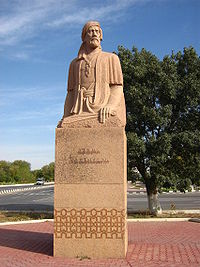
Ajami Nakhchivani
Encyclopedia

Persian language
Persian is an Iranian language within the Indo-Iranian branch of the Indo-European languages. It is primarily spoken in Iran, Afghanistan, Tajikistan and countries which historically came under Persian influence...
: عجمی ابن ابوبکر نخجوانی) - (life: 12th-13th centuries) is a Muslim architect. He is also the founder of the Nakhchivan school of architecture. The influence, which he has rendered on his contemporaries and followers, is reflected in monuments of Nakhchivan architecture.
Yusif ibn Kuseyir tomb
One of the ancient monuments created by Ajami is the tomb of Yusif ibn Kuseyir, known as "Atababa". The ayatsAyats
Ayats is the trading name of Carrocerías Ayats SA, a Spain-based coachbuilder. The company constructs a range of coach bodies on a variety of chassis, and also manufacture their own integral products. Their products are used throughout Europe. The company was established in 1905 by Mr...
(verses) from Koran are inscribed on the walls of the monument. Date of construction of this mausoleum (1161-1162 AD) was defined from its traditional built-in plate or katiba. This eight-sided mausoleum consists of the underground plinth
Plinth
In architecture, a plinth is the base or platform upon which a column, pedestal, statue, monument or structure rests. Gottfried Semper's The Four Elements of Architecture posited that the plinth, the hearth, the roof, and the wall make up all of architectural theory. The plinth usually rests...
burial place (sardaba, Persian: سردابه or cellar) and its on-ground top. Each side of this construction is decorated with various ornaments.
Momine Khatun Mausoleum

Momine Khatun Mausoleum
The Mausoleum of Momine Khatun is located in Nakhchivan City, the capital of the Nakhchivan Autonomous Republic in Azerbaijan...
, also known as the Atabey's Cupola - Atabei Gumbazi. Mausoleum is constructed in honor of Momine Khatun who was wife of either Atabag Shamsaddin Eldegiz himself, or that of his son Jahan Pahlavan. The date, indicated on the walls, tells us that this ten-sided monument was constructed in 1186-1187 AD. Surface of each side is completely covered by the ornaments. In spite of the fact that the upper parts of this structure have some destruction, its height today is more than 25 meters. Here also exists an underground vault and a burial place or sardaba.
One of those creations of Ajami, which partially survived up to present day, is an architectural ensemble near the Momina Khatun Mausoleum. The main building had been destroyed some time ago, only two minaret
Minaret
A minaret مناره , sometimes مئذنه) is a distinctive architectural feature of Islamic mosques, generally a tall spire with an onion-shaped or conical crown, usually either free standing or taller than any associated support structure. The basic form of a minaret includes a base, shaft, and gallery....
s and a portal connecting them have remained. This portal was constructed in 1187 AD. In the opinion of researchers, this composition of two minarets and a portal was originally planned and designed by Ajami.
The Khanagah mausoleum in Nakhchivan strongly differs from what we already have described. While the Momina Khatun Mausoleum and other similar monuments are structures of a tower type, Khanagah mausoleum is a structure of the mixed type: its lower part has the cubic form and the upper part is eight-sided. Ornaments show that the mausoleum was made in 12-13th centuries.
Nakhchivan Juma Mosque
Nakhchivan Juma Mosque monument belongs to Middle Ages as well, and it was also constructed by architect Ajami ibn Abubakr Nakhchivani, and is one of the monuments of Atabeyg architectural complex. It was conserved in the destroyed condition in 19th century.Other Facts
"Memar Ajami" station in Baku metropolitanBaku Metro
Baku Metro is a rapid transit system serving Baku the capital of Azerbaijan. First opened on November 6, 1967, during the time of the Soviet Union, it has the features found in most other ex-Soviet systems, including very deep central stations, and exquisite decorations that blend traditional...
was named in honor of him.

